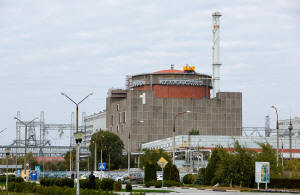Explainer-'Close call' at Ukrainian nuclear plant
 Send a link to a friend
Send a link to a friend
 [November 21, 2022]
By Guy Faulconbridge [November 21, 2022]
By Guy Faulconbridge
LONDON (Reuters) - Ukraine's Zaporizhzhia
nuclear power plant, which is under Russian control, was rocked by
shelling on Sunday, drawing condemnation from the U.N. nuclear watchdog
which said such attacks risked a major disaster.
Repeated shelling of the plant in southern Ukraine has raised concern
about the potential for a grave accident just 500 km (300 miles) from
the site of the world's worst nuclear accident, the 1986 Chornobyl
disaster.
Here is what we know about the incident:
WHAT HAPPENED?
The head of the International Atomic Energy Agency (IAEA) said the plant
came under the most intense shelling of recent months on Saturday,
shortly after 6 p.m. local time, and on Sunday at 9:15 a.m.
There were more than a dozen blasts within 40 minutes, according to the
IAEA.
IAEA experts reported "damage in several places, including a radioactive
waste and storage building, cooling pond sprinkler systems, an
electrical cable to one of the reactors, condensate storage tanks, and
to a bridge between another reactor and its auxiliary buildings".

External power supplies were not affected and radiation levels at the
plant remained normal, the IAEA said.
The biggest risk is from overheating nuclear fuel, which could happen if
the power that drives the cooling systems was cut. Shelling has
repeatedly cut power lines.
Besides the reactors, there is also a dry spent fuel storage facility at
the site for used nuclear fuel assemblies, and spent fuel pools at each
reactor site that are used to cool down the used nuclear fuel.
'CLOSE CALL'
IAEA Director General Rafael Grossi said it was a "close call".
"We were fortunate that a potentially serious nuclear incident did not
happen," Grossi said. "Next time, we may not be so lucky. We must do
everything in our power to make sure there is no next time."
Grossi wants a nuclear safety and security protection zone around the
plant.
[to top of second column]
|

A view shows the Zaporizhzhia Nuclear
Power Plant in the course of Russia-Ukraine conflict outside
Enerhodar in the Zaporizhzhia region, Russian-controlled Ukraine,
October 14, 2022. REUTERS/Alexander Ermochenko

"Even though there was no direct impact on key nuclear safety and
security systems at the plant, the shelling came dangerously close
to them. We are talking metres, not kilometres.
"Whoever is shelling at the Zaporizhzhya Nuclear Power Plant, is
taking huge risks and gambling with many people's lives," Grossi
said.
WHO SHELLED THE PLANT?
Russia and Ukraine blamed each other for shelling the
Russian-controlled plant. Reuters was unable to independently verify
who was telling the truth.
Russia's defence ministry said Ukraine's armed forces fired 11 large
calibre shells at the plant on Nov. 19 and 12 large caliber shells
from 9:15-9:45 a.m. local time on Sunday and then two more at power
lines.
Russia said the shelling was conducted from Marhanets in the
Dnipropetrovsk region.
"The regime in Kyiv does not cease provocations aimed at creating a
threat of a disaster at the Zaporizhzhia nuclear power plant," the
Russian defence ministry said.
Ukraine's nuclear energy firm Energoatom said the Russian military
shelled the plant. It said there had been at least 12 hits on the
plant on Sunday.
"The nature of the damaged equipment at the Zaporizhzhia nuclear
power plant shows that the attackers aimed at, and disabled,
precisely the infrastructure that was necessary for the start-up of
reactors 5 and 6," Energoatom said.
"The Rashysty [a portmanteau of Russian and fascists] once again
engaged in nuclear blackmail and thus endanger the whole world with
their actions!" it said.
(Reporting by Guy Faulconbridge; Editing by Alex Richardson)
[© 2022 Thomson Reuters. All rights
reserved.]
This material may not be published,
broadcast, rewritten or redistributed.
Thompson Reuters is solely responsible for this content.
 |